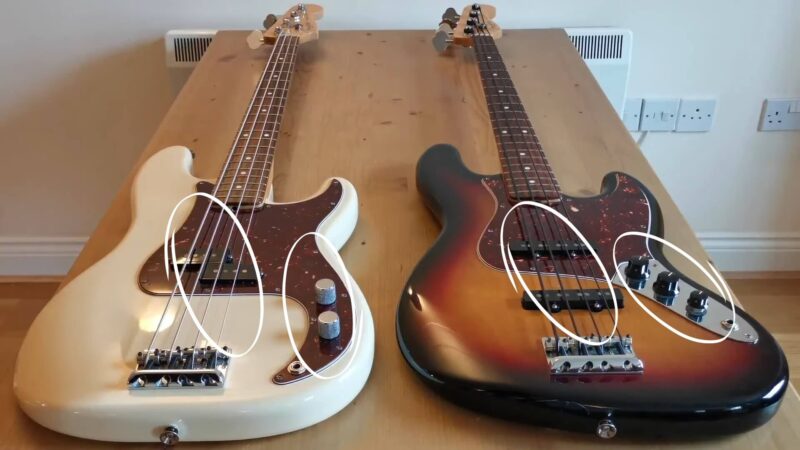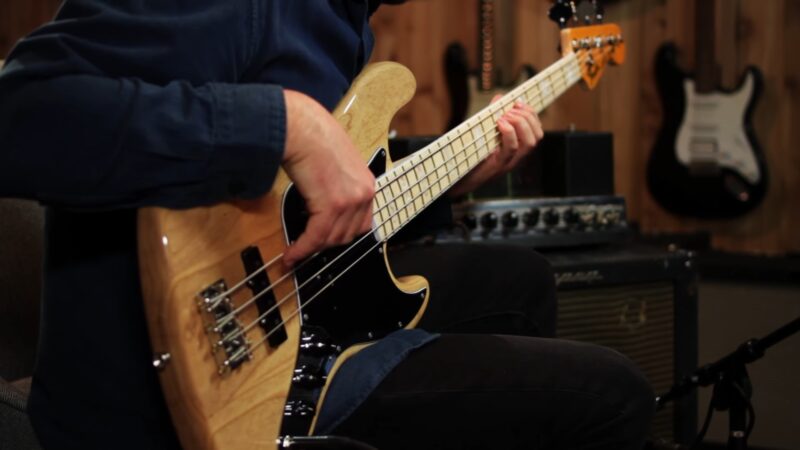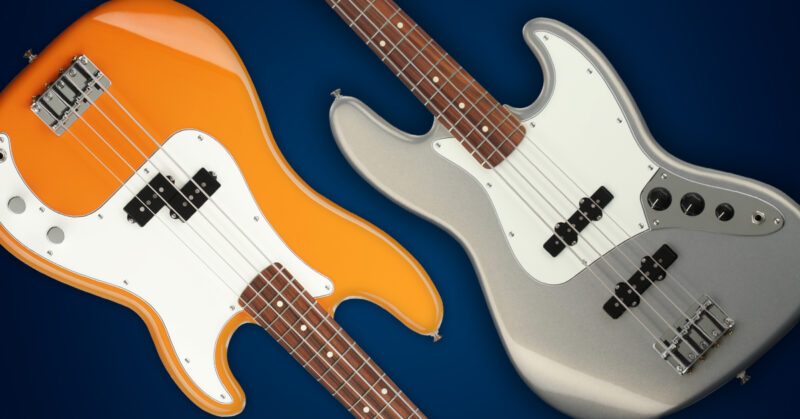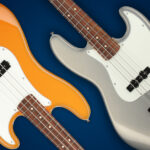At the heart of this exploration is a comparative analysis designed to illuminate the unique attributes and historical significance of the Fender Precision Bass and the Fender Jazz Bass. Introduced in 1951 and 1960 respectively, these instruments revolutionized bass playing, offering musicians a portable, amplified alternative to the traditional upright double bass.
Through their evolution, both basses have left an indelible mark on music culture, influencing genres, techniques, and aesthetic preferences across the board.
Key Takeaways
- An exploration of the physical variations between the basses and how these influence both their playability and visual appeal.
- A detailed analysis of the tonal qualities of each bass and how these align with different musical styles.
- A review of the musical genres and iconic players linked with each bass, underlining their impact on the music world.
- A comparative look at the technical specs of each instrument.
- A brief history of how each model has developed over the years in response to artist feedback and technological progress.
Background and Evolution
| Feature | Fender Precision Bass | Fender Jazz Bass |
|---|---|---|
| Debut Year | 1951 | 1960 |
| Body Type | Solid | Solid |
| Neck Type | Wider | Slimmer |
| Sound Characteristics | Fat, punchy | Wide tonal range, versatile |
| Ideal for Genres | Rock, blues, soul | Jazz, fusion |
| Notable Features | Frets for precision, solid body | Comfortable playability for intricate genres |
What Is the Difference in Design?
The P-Bass is known for its wider neck (1.625″ at the nut) and heavier body, contributing to its sustain and comfort. The J-Bass features a slimmer neck (1.5″ at the nut), catering to players seeking agility and speed.
Both basses share a 34″ scale length, but differ in their pickup configurations; the P-Bass sports a split-coil pickup for a fuller sound, while the J-Bass utilizes two single-coil pickups for tonal versatility.
Impact on Playability and Versatility
The P-Bass is celebrated for its straightforward, robust design, offering a stable and comfortable experience. Its simplicity and punchy tone make it a go-to for rock and punk genres.
The J-Bass, with its faster neck and wider tonal palette, appeals to players requiring flexibility, especially in genres like jazz and funk.
Visual and Aesthetic Differences
| Feature | Precision Bass | Jazz Bass |
|---|---|---|
| Body Shape | Double-cutaway slab | Offset waist, double-cutaway |
| Neck Width | Wider, consistent thickness | Narrower, tapered |
| Pickups | Single split-coil | Dual single-coil |

Does the Sound Differ?
Known for its warm, rich tone, the P-Bass delivers a punchy sound with a pronounced midrange, ideal for cutting through a mix. The J-Bass stands out for its bright, clear sound, with the ability to blend pickups for a customized tone, from smooth and mellow to aggressive and biting.
Musical Expression and Dynamics
The P-Bass’s straightforward sound profile lends itself well to a “set it and forget it” approach, perfect for solid, foundational bass lines. The J-Bass offers more control over tone, suited for players who like to adjust their sound on the fly, catering to complex musical arrangements.
Iconic Sounds and Examples
James Jamerson’s Motown recordings and Sting’s catchy rock lines exemplify the P-Bass’s signature sound. Jaco Pastorius’s jazz-fusion works and Geddy Lee’s rock performances showcase the J-Bass’s versatility.
Are There Differences in Playing Style?
In the domain of rock, punk, and country music, the P-Bass is highly favored for its robust, driving bass lines that anchor the rhythm and energize the melody. Conversely, the J-Bass finds its niche in jazz, funk, and progressive metal, cherished for its agile neck and the capacity for tonal diversity, offering musicians a broad spectrum of sonic possibilities.
Approaches and Techniques
The approach to playing the P-Bass is characterized by a straightforward, rhythm-centric technique. This style accentuates the bass’s foundational role within a band, reinforcing the harmonic and rhythmic structure of the music.
On the other hand, the J-Bass promotes a more exploratory approach to playing. Thanks to its ergonomic design and versatile tonal range, it enables bassists to venture into varied playing styles, including the intricate fingerstyle and the dynamic slap bass, thereby broadening the expressive capabilities of the musician.
Influential Players
The legacy of the Precision Bass in the annals of music history is partly defined by Carol Kaye’s extensive session work and Mike Dirnt’s influential punk bass lines, showcasing the instrument’s versatility and impact. Similarly, the Jazz Bass has been significantly shaped by artists such as Flea and Geddy Lee.
Their innovative use of the instrument has not only pushed the boundaries of its capabilities but also inspired a multitude of bassists to expand their musical horizons and embrace the full potential of the Jazz Bass.
Technical Specifications Comparison
| Specification | Fender Precision Bass | Fender Jazz Bass |
|---|---|---|
| Fret Count | 20 frets | 20 frets |
| Scale Length | 34 inches (standard) | 34 inches (standard) |
| Body Material | Alder or Ash | Alder or Ash |
| Neck Material | Maple | Maple |
| Fingerboard Material | Maple or Rosewood | Maple or Rosewood |
| Neck Width at Nut | 1.625 inches (wide) | 1.5 inches (slimmer) |
| Pickups | Single split-coil | Dual single-coil |
| Bridge | 4-Saddle standard | 4-Saddle standard or HiMass |
| Tuners | Vintage-style | Vintage-style or open-gear |
| Control Layout | Volume, Tone | 2 Volume, 1 Tone |
How Did They Evolve in Time?
The Fender Precision and Jazz Basses have continually evolved since their debuts in 1951 and 1960, showcasing Fender’s innovative response to musicians’ needs and technological advances, and solidifying their status as icons in the music industry with their distinctive sounds and designs.
Fender Precision Bass

- 1951: Introduction with a single-coil pickup, evolving to a split-coil design in 1957, providing the signature punchy tone.
- 1970s: Introduction of the three-bolt neck attachment and additional body contours for improved playability.
- The 1980s and beyond: Variations like the Precision Bass Plus and American Professional series, offer active electronics and modernized features for diverse tonal capabilities.
Fender Jazz Bass

- 1960: Debut with two single-coil pickups, offering a wider tonal palette.
- The 1970s: Addition of the three-bolt neck and bullet truss rod adjustment, enhancing neck stability.
- 1990s to present: Introduction of five-string versions, American Deluxe series with active electronics, and various artist signature models reflecting ongoing innovation.
FAQ
Can you switch the pickups between a Precision Bass and a Jazz Bass to get a hybrid sound?
While technically possible, this modification requires significant woodworking and electrical changes due to the different pickup sizes and configurations. It might affect the instrument’s original tone and resale value.
Do the Precision and Jazz Basses use the same type of strings?
Yes, both basses can use the same types of strings, including roundwound, flatwound, and tapewound, allowing players to choose based on their preferred tone and feel.
How do the neck profiles of the P-Bass and J-Bass affect playing speed?
The slimmer neck profile of the Jazz Bass is generally considered more conducive to fast playing and intricate fingerwork, while the wider neck of the Precision Bass provides a solid grip for aggressive playing styles.
Are there any notable differences in the weight between the two models?
Yes, due to body shape and construction differences, Precision Basses are often slightly heavier than Jazz Basses, which can influence a player’s comfort during long performances.
Can the Jazz Bass achieve the same “punchy” tone as the Precision Bass?
While the Jazz Bass is versatile in tone, achieving the exact punchy midrange of the Precision Bass might require external EQ adjustments or specific pickup settings due to inherent differences in pickup design.
Is there a significant price difference between the two models?
The price can vary depending on the series and specific features, but generally, both models are priced similarly, with variations reflecting factors like special editions, artist models, and custom shop versions.
Final Words
This comparative analysis highlights the unique qualities and histories of the Fender Precision Bass and Jazz Bass, introduced in 1951 and 1960, respectively. These instruments transformed music with their portable, amplified design, influencing musical styles, techniques, and aesthetics worldwide.
The study examines the design differences, tonal characteristics, and suitability for various genres, alongside the impact of legendary musicians who have mastered these basses. By comparing their design and sound, this exploration celebrates their contributions and lasting legacy in the music industry, demonstrating how they’ve shaped the sonic landscape across genres.







